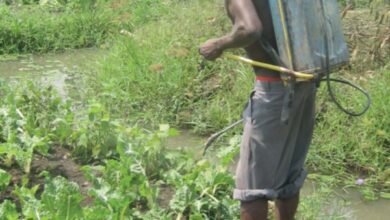Let’s protect and conserve the remaining global snake population for posterity
Diurnal snake species (active during daytime) have round eye pupils meanwhile the nocturnal snake species (those active at night) possess slit eye pupils.

Opinion: According to www.wikipaedia.org, Snakes are described as elongated, limbless/ legless, carnivorous reptiles that taxonomically belong to the Domain Eukarya, Kingdom Animalia, Phylum Chordata, Class Reptilia, Order Squamata and Sub order Serpentine(Ophidia), ranging in length/weight from 10.4 cm long /weight 0.6 grams the Barbados thread snake(Tetracheilostoma carlae) to 8.43 metres long/weight 227 kg the Green Anaconda snake(Eunectes murinus).
They are ectothermic (body temperature primarily varies with their environments) amniotic vertebrates with their skin covered with overlapping keratinous dry scales all over their bodies.
The scales may be smooth, keeled or granular allowing snakes to perform various locomotory movements with ease of grip on different surfaces in their habitats.
Snakes also use different modes of locomotion depending on a particular environment namely body undulations (lateral or vertical), concertina motion (occur when snakes extend and contract their bodies like a spring), rectilinear motion (snakes use their belly scales to move forward), slide-pushing motion (snake pushes its body back and forth to gain traction), sidewinding motion (the snake throw the loop of their body diagonally to the direction they are facing).
All snakes can swim. Aquatic snakes can stay under water for 5-6 hours because they have ability to absorb dissolved oxygen in water through their skins, they can also emerge to the water surface to breathe in more oxygen from the atmosphere as they swim on for example the Northern water snake (Neridia spedon),Yellow bellied sea snake(Pelamis platurus).
The diet of aquatic snake species include fish, amphibians (toads and frogs),tadpoles,insects etc. Some semi-aquatic snake species (stay both on land and water) can stay in water for 10-15 minutes for example the Green Anaconda snake(Eunectes murinus).
Some snakes have efficient senses of hearing (can hear a person whispering), touch(it’s body and the retracticle forked tipped tongue are powerful sensitive organs to vibrations and external temperature/heat changes, smell, taste(uses it’s forked tongue)and sight( with some species able to see through the darkness at night with binocular vision.
Diurnal snake species (active during daytime) have round eye pupils meanwhile the nocturnal snake species (those active at night) possess slit eye pupils.
According to data published by ophidiologists(snake researchers) in Zootaxa online journals, Njaye KS 1996,Rusoke 2020,Wikipedia,Rentokil 2024, there are currently about 3900 recognised existant snake species belonging to 529 genera and about 30 families globally with Uganda having only 171 snake species.
In terms of species diversity, snakes are one of the most diverse groups of squamates on earth whereby living snakes are found on every continent with exception of Antarctica, Ireland and Greenland (these ecosystems are always covered with snow/ice and considered unfavourable to inhabit snakes as temperatures are below negative 0 degrees Celsius or Fahrenheit/very ice-cold environments.
According to Wikipedia;Zootaxa,Rusoke 2020 they list the global snake families and geographic locations with examples as: Anomalepdae found in America for example the Primitive blind snakes; Acrochirdidae found in India, Australia, Philippines, and Malaysia for example Wart snakes; Aniliidae found in Tropical South America for example the False Coral snakes; Anomochiidae found in Malaysia.
Indonesia for example the Dwarf pipe snakes; Atractaspididae found in Africa, the Middle East for example the Burrowing asps; Boidae found in Africa, America, Europe, Asia and Madagascar for example the Boas; Bolyeriidae found in Mauritius for example the Split jaw snakes; Colubridae found in in all continents except Antarctica for example all typical snakes including the Vine/Twig snakes, Boomslangs; Cyclocoridae found in Philippines for example the Cyclocorids; Cylindrophiidae found in Asia, China for example the Asian pipe snakes;
Elapidae(the fixed hollow fanged snakes) found in tropics and sub tropics worldwide except in Europe with Sea snakes found in Indian and Pacific oceans for example Elapids; Gerrhopilidae found in Asia, Philippines, and New Guinea for example the Blind snakes; Homalopsidae found in Asia, Australia for example Homalopsids; Lamprophiidae found in Africa including Seychelles for example Lamprophiids; Leptotyphlopidae found in Africa, Asia, America for example Slender blind snakes,Thread snakes; Loxocemidae found in Mexico.
Costa Rica for example Mexican Burrowing snakes; Micrelapidae found in Eastern Africa for example the Two-headed snakes; Pareidae found in Asia for example Snail eating snakes; Prosymnidae found in Sub-Saharan Africa for example the Shovel snout snakes; Tropidohiidae found in Brazil, Panama, West Indies, America for example the Dwarf Boas; Typhlopidae found in all tropics/subtropics worldwide, Africa, America for example all typical blind snakes;
Psammophiidae found in Africa, Madagascar, Asia, Europe for example Psammophiids, Pseudaspididae found in sub-Saharan Africa, Asia for example Pseudaspidids; Pseudoxyrhophiidae found in Madagascar, Africa and the Comoros for example the Pseudoxyrhophiids; Pythonidae(the large constrictors) found in Sub-Saharan Africa, India, China, Asia, Australia, New Guinea for example Pythons; Uropeltidae found in India,Sri Lanka for example the Shielded tailed snakes; Viperidae(hinged hollow fanged snakes) found in Africa, Asia, America, Europe for example the Vipers; Xenopeltidae found in Asia, Myanmar, China, Philippines for example Sunbeam snakes; Xenophidiidae found in Borneo, Malaysia for example the Spine jawed snakes; Xenotyplopidae found in Madagascar for example Round nosed blind snakes.
According to Njaye KS etal 2005, Rusoke 2020, one can identify snake species in the wild or any habitat using the following criteria:
- Colour patterns,
- Type of scales, size and appearance, · Shape of the pupil of the eye,
- Type and shape of dentition/teeth/fang,
- Habitat type/environment where snake dwells (terrestrial, arboreal, montane, aquatic, wetland, desert etc),
- Its behavioural reaction when provoked, · The position of the head during motion (raised or lowered), · Its position when encountered. According to the International Union of Conservation of Nature (IUCN) Red list of Threatened species, 12 % of the assessed global snake species are listed as threatened and their population is in decline.
Alarmingly, most of the world reptile species including snakes are yet to be assessed by IUCN, this implies the global conservation status of reptiles including for snakes is unknown.
Examples of globally threatened snakes species are the Santa catalina rattle snake species (Gulf of California), the Madagascar blind snake species, the Three banded centepede snake species (Honduras).
According to Rentokil 2024, Rusoke 2024, some examples of snake species in Uganda are: African rock python (Python sebae), Ball Python (Python regius), Black mamba (Dendroaspis polylepis), Green mamba (Dendroaspis augusticeps), Boomslang (Dispholidus typus), Egg eating snake (Dasypelitis scabra), Cape cobra (Naja nivea), Snouted cobra (Naja annulifera), Egyptian cobra (Naja naje), Brown Forest cobra (Naja subfulva), Black necked spitting cobra (Naja nigricollis), Puff Adder (Bitis arietaus), Gaboon viper (Bitis gabonica), Rhinoceros viper (Bitis nasicornis), Night Adder (Causus rhombeatus), Ring-necked spitting cobra (hermachatus hermachatus), Vine snake (Thelotornis capensis), Spotted Bush snake (Philothamnus semivariegatus), Red lipped snake (Crotaphopeltis hotamboeia), Blanding tree snake (Toxicodryas blandingii), Emerald snake (Hapsidophrys smaragdinus), Brown house snake (Boaedon fulignosus), to mention but a few.
According to the Zootaxa online journal(2024)Snakes are thought to have evolved over time from the Burrowing aquatic lizards during the Jurassic period (145-201.3 million years ago mya) and became adapted to live in diverse habitats such as on land, deserts and rocky areas (terrestrial) ,on trees (arboreal), water/ lakes/ oceans/ seas(aquatic), on mountains(montane) habitats/environments.
In terms of nutrition/diet feeding, all snakes are carnivorous preying on the following organisms for example rodents, lizards, frogs, toads, other small snakes, birds, eggs, fish, snails, small mammals, worms, insects etc.
Snakes reach sexual maturity within 2-4 years depending on the species and habitat. In captivity snake can live between 20-50 years, in the wild the snakes live for a short period than this because they are exposed to predation. According to Njaye KS 2005, the three main categories of snakes depending on how potency or absence of venom are: · Venomous (possess venom and very dangerous) snakes for example vipers, cobras etc
- Semi-venomous (partly dangerous or injurious) for example some house snakes when provoked.
- Non-Venomous (lack venom but can kill or injure prey/victim by swallowing, constriction or mild biting) for example Pythons.
Majority of the snake species are nonvenomous (may be harmless because they lack venom but can cause death by constriction of the prey or by swallowing prey alive for example the Pythons and Boas) while minority are venomous (harmful and very dangerous) to humans as they may cause deaths through snakebite envenomation (they have venom), cause permanent body injuries to their prey/ victims leading to sometimes amputations.
Venomous snakes use their venom to kill and immobilise their prey rather than for self-defence.
According to the World Health Organisation (WHO) 2024 Snakebites are public health concern globally with approximately 5.4 million people exposed to snakebites,as a result 1.8 -2.7 million snakebite envenomation related deaths occur per year, between 81,410-137,800 with amputations coupled with other permanent disabilities.
In response to this crisis, World Health Organisation (WHO) has classified snakebites as a Neglected Tropical Disease (NTD) to help mitigate and offer treatment to the increasing number of cases as a result of envenomation from snakebites globally, and also to protect the snake species from being indiscriminately killed by humans even if even these snake species pose no real threats to the human populations that interface/interact them.
According to the World Health Organisation (WHO), there are four types of snake venom. These are: · Neurotoxins: these affect the victim’s nervous system and prevent neurons in the brain from transmitting signals, this may case paralysis to the prey/victim; · Haemotoxins: These affect the blood circulatory system and cause the red blood cells(erythrocytes) to burst causing the blood to clot and also reducing the victim’s blood pressure(BP),
Cytotoxins: These cause necrosis or death of cells in the body hence eventually the prey/victim may also die.
Mytoxins: These affect the muscular system of the victim/prey causing necrosis or tissue death in muscles. Venom is inject into the victim’s body by the snake’s fangs (a pair of modified hollow teeth located on the upper jaw of the snake’s mouth). Elapids such as cobras are proteroglyphous (possess hollow fang, which cannot be erected towards the front of their mouths and cannot “stab” like the fangs of the viper snake, they actually bite the victim).
Venomous snakes are classified into three taxonomic families namely: · Elapids for example Cobras ,Mambas, Kraits, Sea snakes, Australian copperheads, Coral snakes; Viperids for example Vipers, Rattlesnakes, Copperheads, Bushmasters · Colubrids: This family consist of (rear fanged) snakes and other snake species for example the Boomslangs, Tree snakes, Vine snakes etc. Reproduction: All snakes use internal fertilization.
The male snake possess a pair of hemipenes(a grooved/spined/hooked organ designed to grip the female snake’s cloaca during copulation). Most snake species lay eggs(oviparous) which they abandon to leave them hatch with exception of the King Cobras and Pythons incubate their eggs until they hatch out.
Some snake species are ovoviparous, this implies retain the fertilized eggs in their bodies till they are ready to be hatch out, meanwhile other snake species are viviparous this implies they produce live young ones for example the Boas and the Anaconda snakes.
Behaviour: During cold temperatures/winter, snakes enter a period of dormancy known as brumation(a period in which snakes are awake but inactive).Snakes may brumate in burrows, under rocks piles, inside fallen trees, pile of bricks etc; this behaviour is different from hibernation where the organism taking refuge underground is alive but it’s inactive for some time as a survival strategy so as to overcome the winter or a dry season for example as exhibited by the Mud fish. Hooding/spitting/hissing. Some snake species can expand their neck area(hooding) followed by spitting venom towards their victims/prey or produce hissing sounds as a visual deterrent in an attempt to scare away their victims or send intent attack/strike signals for example the Cobras(Elapids) and other snake species. Snakes also undergo a process of ecdysis/moulting/sloughing by shedding off its skin/scales 4-5 times every year.
Snakes also are cryptic in nature and possess a wide diversity of skin coloration patterns, which they use for camouflage to blend with their environments, and to hunt their prey or even flee from predation. Snake-human interaction/Importance include:
- Venom is used in the manufacture of medicines/drugs to treat human diseases, · Antivenom prepared from snake venom is used to treat snakebite envenomation, · Ecologically snakes play important roles in the ecosystem by controlling pests and small mammal populations, stabilise the food web as a top predator; · Economic benefits derived from sale of live snakes and their products;
- Commercial snake farming especially in Asia,China and other countries.
- Captive breeding for the purpose of re-introducing to some snake species back to the wild, · Snakes can be trapped and kept as pets or supplied to zoos;
- As a foreign exchange earner to the country when revenue is realised from Snake tourism from visitors/tourist who come to for snake viewing expeditions and entertainments for tourism purposes. · Snakes can be enjoyed as delicacy/food by some people in the world for example majority of the Asian nationalities like the Chinese are said to eat snakes as delicacies, · Religious/cultural significance:
Snakes were and are still used as symbols of worship by people of some cultures and religion in different parts of the world for example as in Hinduism; Snakes are also used as a symbol of power, wisdom and knowledge as was in Genesis the first book of the Christian Bible in the story of Adam and Eve, God and the forbidden Tree in the garden of Aden.
According to the Save the Snake Conservation Group(2024), Global threats to snake population include: · Human activities (anthropogenic factors) such as habitat destruction, deforestation, encroachment, fires, urbanization, pollution, farming/agricultural practices, · Indiscriminate killing of snakes by the communities, they view snakes as deadly creatures though some snake species are harmless to man, · Over harvesting/trapping and illegal trade; · Road kills of snakes/accidents by moving traffic;
- Depredation of snakes by other predators and by other larger cannibalistic snakes; · Research on snake species is inadequate, often underfunded and not prioritized by the relevant authorities,
- Lack of adequate funding by governments/groups/institutions to protect and conserve snakes species worldwide,
- Climate change. Mitigations measures for global protection and conservation snake species:
- As we prepare to celebrate the World Snake Day(WSD) on 16th July 2024 there is an urgent need to carry out community sensitizations, environment education(EE), conservation education(CE) and Snake Education about the significance of protecting and conserving the remaining global snake populations for the benefit of our future generation and posterity;
- Involve the participation of all stakeholders namely the public, government, development partners, conservation organizations and Nongovernment organizations. · Enforcement of regulations to protect and conserve the remaining snake species by responsible international/Regional/Local organisations;
- Carry out and promote snake conservation efforts through community sensitization, community education, environment education;
- Encourage snake farming ventures by private enterprises in form of snake farms; · Promote captive breeding of snakes for re-introduction to the wild by State institutions for example zoos; · Sourcing snake venom for research and production of medicines/drugs to treat human diseases such as Parkinson disease, heart attack, high blood pressure, stroke, cancer, Alzheimer’s disease, pain and snakebites.
- Monitor and supervise the over harvesting and trade of live snakes and their products by the responsible authorities such as the International convention for the trade in endangered species of flora and fauna (CITES). In conclusion, There is a need to involve all stakeholders at all levels namely global/region/national/local to protect and conserve the remaining global population for our future generation, posterity and also benefit from products of snakes especially the snake venom used in the manufacture of a variety of medicine/drugs that can treat a number of incurable human diseases, and to safeguard the ecological roles played by the snake species in the ecosystem as a top predator.
It should also be noted here that a high snake species diversity in a given habitat clearly indicates the existence of a healthy and balanced ecosystem. Let us all nurture and exhibit love for snakes and be attracted to them (ophidiophilia) and desist from the phobia of fearing snakes (ophidiophobia).
REFERENCES:
IUCN (International Union of Conservation of nature) www.iucn.org (Date accessed 10th April 2024) Njaye KS (1996) Diploma in Wildlife Management Course Notes, College of African Wildlife Management Mweka Moshi Tanzania.
Njaye KS (2005) Bachelor of Science in Wildlife Health and Management degree Course Notes, Faculty of Veterinary Medicine, Department of Wildlife and Animal Resources Management, Makerere University, Uganda. Rentokil (2024) Snakes species found in Uganda, www.rentokil.co.ug (Date accessed 10th April 2024), Rusoke T (2020) Snakes of Uganda,Nkumba University,
The author is Kizito Simon Njaye, Research Association African Research Consult – Uganda Chapter.
Disclaimer: As UG Reports Media LTD, we welcome any opinion from anyone if it’s constructive for the development of Uganda. All the expressions and opinions in this write-up are not those of UG Reports Media Ltd. but of the author of the article.
Would you like to share your opinion with us? Please send it to this email: theugreports@gmail.com.






